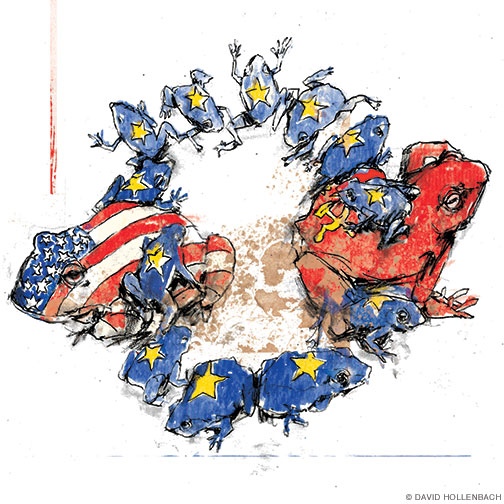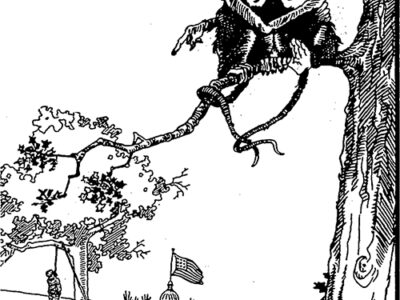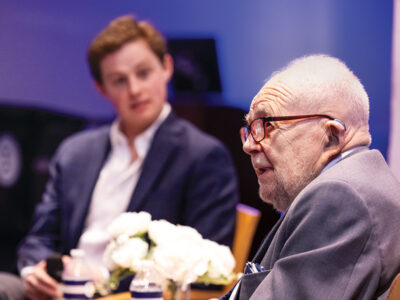
What really ended the Cold War?
By William Ewald
In 1929 George Kennan, a foreign service officer still in training, was assigned to the American legation in Riga, Latvia, which was as close as he could then get to the Soviet Union. For the next four years he was an obscure young man in an equally obscure diplomatic outpost. He spent his time reading history, learning languages, talking to the locals, and listening to Soviet political propaganda. It was an isolated existence, and he had only a very restricted view of world events: the view of a small frog on the edge of a large pond. But small-frog perspectives have their uses. Compared to his bosses, the much larger frogs in Washington, DC, Kennan had the advantage of geographical proximity, and a remarkable ability to notice what was happening around him. His view was narrow, but it did enable him to detect certain local ripples of world events—providing insights that would profoundly shape US foreign policy after World War II, by which time Kennan had been posted to Moscow.
Sixty years after Kennan went to Riga, the Soviet Union fell apart. What happened? According to a widespread story, believed by certain big frogs in Washington, what happened was this:
After the presidencies of Gerald Ford and Jimmy Carter discredited the policy of détente, President Ronald Reagan took a new approach. His approach—his arms buildup, his willingness to outspend the Soviet Union, his stationing of Pershing II missiles in Europe, his steadfast refusal to bargain away the Strategic Defense Initiative, his insistence that communism must be defeated rather than contained, his denunciations of the Evil Empire, his call to “tear down this wall”—caused the leadership of the Soviet Union to face reality, acknowledge American superiority, and throw in the towel. Soviet leader Mikhail Gorbachev, it is conceded, was somehow involved. So (at any rate around the periphery) were Margaret Thatcher and Pope John Paul II and perhaps even Helmut Kohl. But it is a story overwhelmingly focused on the United States—more specifically, on Washington, and, more specifically still, on the part of Washington concerned with the military. And if you believe it, then of course you are going to favor a certain approach to foreign policy.
No doubt there is some truth to that story, at least in part. But let me mention my own froggish perspective. It is entirely anecdotal, and I claim for it no scientific validity. Its only virtue is to conflict with things that are perhaps too quickly taken for granted.
For about three years, from 1985 to 1987, I studied at the University of Göttingen under the auspices of the Alexander von Humboldt Foundation. Geographically, Göttingen was on the front line of the Cold War. A short hike would bring you to the East German border, with a fence, watchtowers, and guards who never waved back. The Pershing II missiles had just been stationed in Germany, over massive protest. Soviet General Secretary Yuri Andropov had just died; the 40th anniversary of the end of World War II came and went; former West German Chancellor Helmut Schmidt remarked that the question of German reunification “was not for this century”—implying that it was unlikely to be a question for the next century, either. The European Economic Community (EEC) had been stagnant for more than a decade. The geopolitical situation appeared set in ice.
Most of my friends were German graduate students, working on legal theory and legal history. A number of Eastern Europeans studied in the law department (and I met many others elsewhere in the wider world of Humboldt Fellows). They were top students, studying on various fellowships from the German government, and they were intensely interested in Western law. There was a weekly colloquium that met in the evenings. Afterwards, the group would head for a Bierstube. The discussions, heavy with cigarette smoke, would continue deep into the night.
One memorable evening brought a visitor from Poland to give a talk. After several hours of academic discussion (and more than several beers), he mentioned that during his military service he had commanded tanks. One of my German friends perked up. “That is what I did,” he said. (Conscription was universal for young Germans then.) They compared notes.
My German friend explained what it was like to drive one of the new Leopard 2 tanks: You’d be bouncing along at high speed over rough terrain, the entire tank shaking, but a precision gyroscope would hold your gun perfectly level, locked onto its target. All you needed to do was push a button. The technology, he said, was astonishing.
The Pole said yes, he had heard about those tanks. Things were a bit different in Poland. He had about 40 tanks under his command. On a good day, maybe half of them would start. The rest, he said, were garbage. “But it doesn’t matter,” he continued. “If there is a war, you don’t need to worry. My men won’t fight. Not even if you give them your good tanks. They’ll desert.” He paused. “At any rate, that will be the second thing they do.”
“Really?” somebody asked, a bit startled. “What’s the first?”
The Pole switched pronouns. “First we cut the rail lines. That’s to screw the Russians. Then we go home, or surrender, or fight for NATO.” There was a longer pause, and I naïvely inquired: Are the Russians aware of this? He was scornful. “Of course they are aware. They have no friends in Poland. Everybody knows it.”
A graduate student from Budapest spoke up, irritated. The entire discussion, he said, was beside the point. The Soviet army was never going away. It had grabbed half of Europe, and it would be there forever. There was nothing the Poles could do about it. They were just blowing hot air. 1992 was just a few years off. After that, central Europe was finished.
I had many similar conversations during those years. They all circled back to the central points: the widespread dislike of the Soviet occupation, frustration at being cut off from the rest of Europe, the dejected sense that nothing was ever going to change, and that 1992 was looming.
Then came the Chernobyl disaster, Gorbachev’s first tentative liberalizations, and a relaxation of tensions. And then it was 1989, Hungary opened its borders, hundreds of thousands of people took to the streets, and the whole Cold War business, which had seemed so permanent just two years earlier, simply collapsed.
Why did it happen? What brought those people into the streets? And, for that matter, what was the significance of 1992?
In informal conversations, I have put this question to a number of policymakers in Washington. Most of them were medium-sized frogs, but there were also a few large ones. I have yet to meet one who knew the answer. Most responded with a look of bafflement.
In 1986, the EEC had long been in a state of what everybody called “Eurosclerosis.” Nothing new was happening, and even things that had long since been agreed were not getting done. The entire project was stagnating. So in 1986, the leaders of the EEC signed the Single European Act. The Single European Act was an effort to get things moving. It did not attract a great deal of attention in the United States: just another dull European summit. But it set 1992 as the target date for consolidating the internal European market. That date, taken so casually in the West, evidently set off alarm bells in Eastern Europe. That was what the people I was talking to were talking about. There was almost a sense of desperation. After 1992, there would be no catching up to the rest of Europe—ever.
What does all of this have to do with the story that attributes the end of the Cold War to American military spending? All I can say is, from the frog perspective of Göttingen it didn’t look that way, even a little. Nobody was talking about the Pentagon budget, or even very much about NATO. But a lot of people were talking—quite obsessively—about the future of what is now known as the EU. (The new name was adopted in the Maastricht Treaty—fittingly enough, in 1992.)
I am of course aware that this little story is just an anecdote. But sometimes the view from a place like Göttingen or Riga can tell you something worth thinking about. And, as it happens, there is a rather large gap in the familiar story. What did bring all those millions of Eastern Europeans onto the streets in 1989? Was it because they suddenly noticed that Pershing II rockets were pointed at their heads? Is that the way large numbers of people habitually act? Or could it have been something else?
The matter can of course be studied, most obviously by asking the people who were involved. I am not aware of any such systematic study. Until that work is done, the familiar big-frog story is also just an anecdote with no scientific backing: extremely isolated, and, given its influence on the making of foreign policy, dangerously far removed from events on the ground.
William Ewald is Professor of Law and Philosophy at Penn Law, where he teaches comparative law. (This essay was originally written for Perry World House.)




